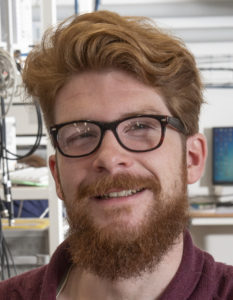 On Friday, June 14th 2024, we have the pleasure to welcome in SPINTEC William LEGRAND from CNRS-Institut Néel. He will give us a seminar at 11:00 entitled :
On Friday, June 14th 2024, we have the pleasure to welcome in SPINTEC William LEGRAND from CNRS-Institut Néel. He will give us a seminar at 11:00 entitled :
Towards magnonics at low temperatures
Place : IRIG/SPINTEC, auditorium 445 CEA Building 10.05 (access to CEA requires an entry authorization. Request it before June 04th at admin.spintec@cea.fr)
video conference : https://webconf.cea.fr/vincent.baltz/TFGF6GL6
IF THE LINK DOES NOT WORK, try with skype web App : https://webconf.cea.fr/vincent.baltz/TFGF6GL6?sl=1
or by phone +33 1 69 35 55 10 conf ID : 722967786
Abstract : Magnetically ordered ensembles such as ferromagnets experience elementary excitations, quantized into magnons [1]. These are foreseen as a potential means of conceiving non-Boolean electronics, in which microwave-frequency magnons carry information, are generated and collected between transducers, and interact or interfere to implement various functionalities [2].
The fundamental properties of magnons as well as their hybridization with light have been studied in the context of cavity quantum electrodynamics [3,4]. Similar to spin ensembles [5], the integration of nanoscale magnetically ordered elements with superconducting resonators into hybrid systems [6-8] would open great prospects for understanding the quantum properties of magnons and for building devices for cryogenic use. A barrier to these experiments lies in the poor ferromagnetic resonance of nanomagnets at cryogenic temperatures, which calls for new approaches in the epitaxial synthesis of thin film magnetic insulators.
We will mainly discuss one proposed path to address this long-standing issue, based on the partial substitution of cations in the garnet structure of yttrium iron garnet [9]. On the way, I will also introduce instrumentation and techniques that are relevant to this class of experiments, and some general ideas about the inductive coupling between magnons and photons.
- Holstein, T. & Primakoff, H., Field Dependence of the Intrinsic Domain Magnetization of a Ferromagnet. Phys. Rev. 58, 1098‒1113 (1940).
- Pirro, P. et al., Advances in coherent magnonics. Nat. Rev. Mater. 6, 1114‒1135 (2021).
- Tabuchi, Y. et al., Hybridizing Ferromagnetic Magnons and Microwave Photons in the Quantum Limit. Phys. Rev. Lett. 113, 083603 (2014).
- Lachance-Quirion, D. et al., Entanglement-based single-shot detection of a single magnon with a superconducting qubit. Science 367, 425‒428 (2020).
- Wang, Z. et al., Single electron-spin-resonance detection by microwave photon counting. Nature 619, 276‒281 (2023).
- Li, Y. et al., Strong Coupling between Magnons and Microwave Photons in On-Chip Ferromagnet-Superconductor Thin-Film Devices. Phys. Rev. Lett. 123, 107701 (2019).
- Hou, J. T. & Liu, L., Strong Coupling between Microwave Photons and Nanomagnet Magnons. Phys. Rev. Lett. 123, 107702 (2019).
- Guo, S. et al., Strong on-Chip Microwave Photon–Magnon Coupling Using Ultralow-Damping Epitaxial Y3Fe5O12 Films at 2 K. Nano Lett. 23, 5055‒5060 (2023).
- Legrand, W. et al., Lattice-tunable co-sputtered substituted iron garnets for low-temperature magnonics (in prep.).
Biography :
- Ph.D. from Unité Mixte de Physique CNRS/Thales (now Laboratoire Albert Fert) in 2019.
- Post-doc in Hybrid Quantum Circuits group at LPENS in Paris (2019-2021).
- Post-doc in group of Magnetism and interface physics at ETH Zurich (2021-2023).
- Started as permanent CNRS researcher in Institut Néel beginning of 2024.




